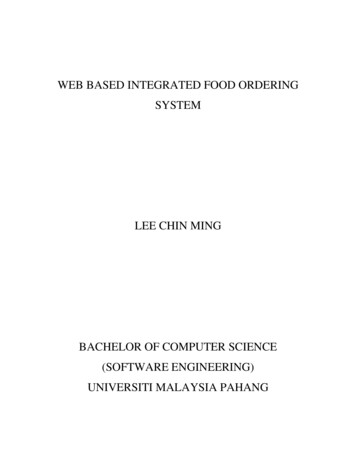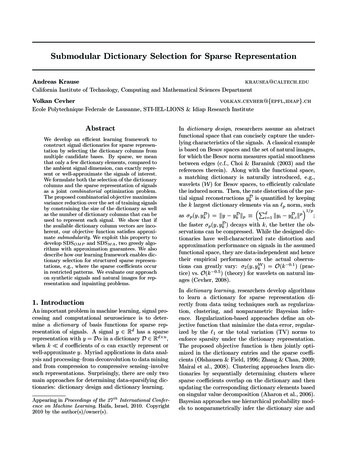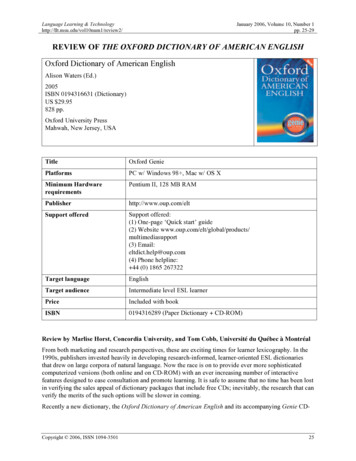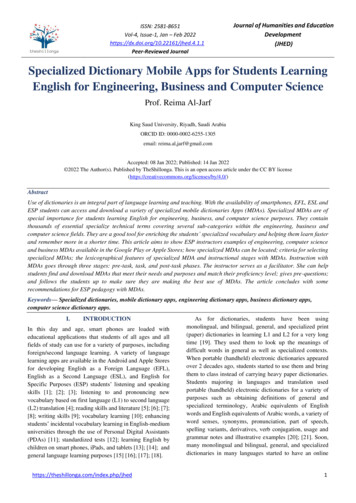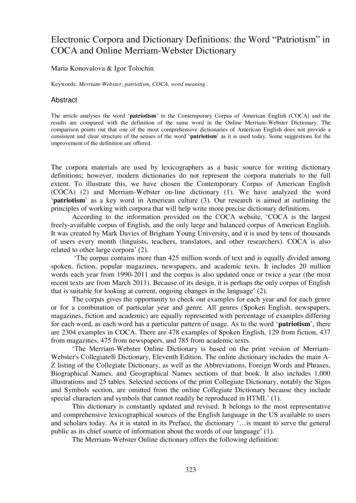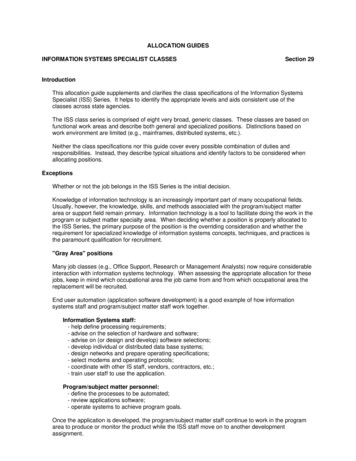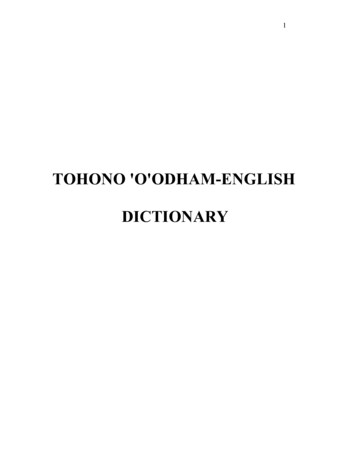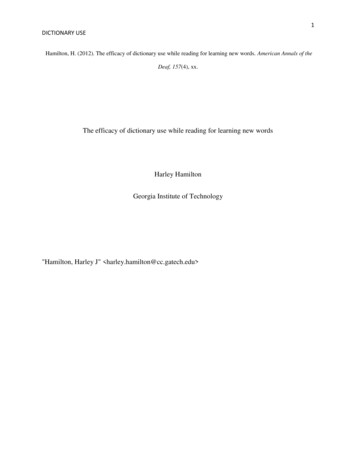
Transcription
1DICTIONARY USEHamilton, H. (2012). The efficacy of dictionary use while reading for learning new words. American Annals of theDeaf, 157(4), xx.The efficacy of dictionary use while reading for learning new wordsHarley HamiltonGeorgia Institute of Technology"Hamilton, Harley J" harley.hamilton@cc.gatech.edu
2DICTIONARY USEAbstractThis paper describes a study investigating the use of three types of dictionaries by deaf(i.e., with severe to profound hearing loss) high school students while reading to determine theeffectiveness of each type for acquiring the meanings of unknown vocabulary in text. Thedictionary types used include an online bilingual multimedia English-ASL dictionary(OBMEAD), a paper English-ASL dictionary (PBEAD), and an online monolingual Englishdictionary (OMED). Results indicate that for immediate recall of target words the OBMEADwas superior to both the PBEAD and the OMED. For later recall, no significant differenceappeared between the recall for words learned via use of OBMEAD and PBEAD. Recall for eachof these was statistically superior to recall for words learned via OMED.
3DICTIONARY USEThis paper describes a study investigating the efficacy of dictionary use by deaf (i.e., withsevere to profound hearing loss) students during reading text passages that contain unknownwords. The importance of vocabulary, deaf and hard of hearing readers’(i.e., with slight toprofound hearing loss) vocabulary knowledge, methods of acquiring vocabulary, challengesfaced, and the use of dictionaries will serve as background for this study.The importance of vocabulary“Vocabulary is essential for communicating, reading,thinking, and learning.” (Luckner & Cooke, 2010)Learning vocabulary is an incremental process that begins at birth and continuesthroughout life. It does not start upon school entrance but is begun in the home. Research (e.g.,Anglin, 1993; Biemiller, 2005, 2006; Biemiller & Slonim, 2001) suggests that average hearingchildren acquire the meaning of about 860 English root words per year (e.g., desk, sleep, cousin),or about 2.4 root words per day, for a total of approximately 6,000 root words by the end of 2ndgrade. As education continues the need for vocabulary grows exponentially. Nagy and Anderson(1984) estimated that school texts from grades 3 through 9 contain approximately 88,500 distinctword families. In word families the relationship of words are “semantically transparent.” That is,the meaning can be determined by using knowledge of the root word and the context of the text.For example the word family laugh would contain the root word laugh and its derivativeslaughs, laughed, laughing, and laughter but not laughingstock. Coady (1997) states that thethreshold for independent English reading is 5,000 word families. Clearly, acquiring meaningsfor this many words is a formidable task. This ongoing process of learning word families isnecessary in the lifelong quest to master the estimated 450,000–750,000 words that make up the
4DICTIONARY USEEnglish language (Stahl, 1999; Tompkins, 2005) in order to ensure the development of readingcomprehension and academic success.General knowledge of spoken words is a strong indicator of reading ability for hearingindividuals and this is particularly true for children (Cunningham & Stanovich, 1997; Tabors,Snow, & Dickinson, 2001). Research with hearing individuals indicates that a reader must know90-95% of the words in a passage to fully comprehend it (Carver, 1994; Chall, Jacobs, &Baldwin, 1990; Na & Nation, 1985, Laufer,1989; Hu & Nation, 2000, Nagy & Scott, 2000).Haynes and Baker (1993) have suggested that the most significant handicap for second language(L2) readers of English is not lack of reading strategies but insufficient English vocabulary.Specifically, one of the most enduring findings in reading research is the extent to whichstudents’ vocabulary knowledge relates to reading comprehension (Alderson & Freebody, 1981;Baumann, Kame‘enui, & Ash, 2003; Becker, 1977; Whipple, 1925; National Reading Panel ,2000). Cobb and Horst (2001) state that vocabulary is more important than other types oflinguistic knowledge, including syntax. The National Reading Panel (2000) concluded thatcomprehension development cannot be understood without a critical examination of the roleplayed by vocabulary knowledge. Vocabulary knowledge is not only related to readingcomprehension but also to content area knowledge (Holmes, Holmes, & Watts, 2012; Nagy &Townsend, 2012).Investigating young hearing children, Hart and Risley (2003) have referred to a lack ofvocabulary as “the early catastrophe” and have provided evidence that lack of vocabulary andEnglish language skills adversely affect a child’s English reading ability and overall academicsuccess, sometimes irreversibly (Hart & Risley, 1995). Given that students’ success in schooland beyond depends in great measure upon their ability to read with comprehension, there is an
5DICTIONARY USEurgency to providing instruction that equips students with the skills and strategies necessary forlifelong vocabulary development.Deaf and hard of hearing readers’ vocabulary knowledgeNinety-five percent of children who are deaf or hard of hearing are born into families with at leastone hearing parent (Mitchell & Karchmer, 2004). Most of these families use speech as the primary modeof communicating with their children who have hearing loss. Specifically, 92.5% of these families usespoken English in the home, 21.9% use spoken Spanish in the home, and only 3.8% of families use ASLin the home (Gallaudet Research Institute, 2008). In school, the majority of students who are deaf or hardof hearing (i.e., 52%) use speech only as their primary mode of communication; 34.9% use sign withspeech, and 11.4% use sign only (Gallaudet Research Institute, 2008).The majority of children who are unable to adequately utilize speech as an expressive orreceptive communication mode typically grow up in linguistically impoverished surroundingsdue to the inability of family members to use some form of fluent signing (Goldin-Meadow &Mylander, 1990, Goldin-Meadow, 1999). Their slow development of language, includingEnglish vocabulary (Luckner &Cooke, 2010), has been attributed to inadequate linguisticinteraction (Spencer & Lederberg, 1997) and incomplete language models (Hamilton & LilloMartin, 1986), “the early catastrophe”. For deaf and hard of hearing children “the earlycatastrophe” affects their reading ability and ability to learn academic content (Hamilton, 2011).This is evidenced by the fact that fifty percent of deaf and hard of hearing high school graduatesread at the 4th grade level or below (Gallaudet Research Institute, 1996; Traxler, 2000) and 30%leave high school functionally illiterate (Marschark, 1997; Marschark, Lang, & Albertini, 2002).Only 7-10% of deaf and hard of hearing students read beyond 7th to 8th grade reading level(Strong, & Prinz, 1997; Luckner, Sebald, Cooney, Young III, & Muir, 2006) The academicachievement of deaf and hard of hearing students has remained at these levels for approximatelythirty years (Qi & Mitchell, 2007) regardless of the educational or language policy of the day.As discussed earlier, a major factor that affects English reading ability is Englishvocabulary knowledge. More specifically, for all readers, both the breadth and depth ofvocabulary knowledge are critical (Anderson & Freebody, 1981). Vocabulary breadth is thenumber of words a person knows. Studies have shown that the breadth of deaf and hard of
6DICTIONARY USEhearing students’ lexicons is smaller than that of hearing students (Luckner & Cooke, 2010). Notsurprisingly, vocabulary breadth has also been positively correlated with reading comprehensionfor deaf and hard of hearing students (Luckner & Cooke, 2010). Albertini and Mayer (2011)have reported that even for college level deaf (moderately severe-to-profound hearing loss)comprehension of basic grade school-level passages depended on the ability to recognize andcomprehend key vocabulary in the texts.The depth or quality of vocabulary knowledge is also of importance in reading (Shen2008). Depth entails knowing multiple meanings for a word such as the numerous meanings of“run”. It also includes the finer semantic distinctions such as the difference between “happy” and“giddy” or “bad”, “evil’, and “wicked”. For deaf and hard of hearing readers, depth ofvocabulary knowledge is also lacking but highly important for supporting readingcomprehension (Paul, 1996).Methods of attaining vocabulary knowledgeAccording to Paul (1996) it is necessary to teach vocabulary, especially to poor readers,who are not likely to derive many word meanings from the use of context. Paul (1996) hassuggested that print vocabulary instruction for deaf and hard of hearing students should evolvefrom traditional approaches, such as learning definitions for a vocabulary list or definitions-andcontext approach (Nagy, 1988; Paul, 1989; Paul & Gustafson, 1991). In traditional definitionand-contextual approaches, the teacher might have a list of words that are important for studentsto know prior to a lesson. After practice with pronouncing and signing the words, and learningthe particular definitions, students might be required to use the words in sentences. For example,the student might write "very sad" as a meaning for the word tragic and create a sentence such as
7DICTIONARY USE"The Braves loss was tragic". It would not be uncommon with such an approach for a student towrite “I was tragic”.This method is problematic for several reasons: The target text may have a great many words that are unknown to students – too many fordirect instruction. Direct vocabulary instruction can take a lot of class time – time that teachers might betterspend having students read (if the passages are within the students independent readinglevel). Students need opportunities to use word-learning strategies to independently learn themeanings of unknown words.(Armbruster, Lehr, & Osborn, 2001)Conway(1990) has stated:“Traditional programs of learning definitions forlists of words should give way to learning words insemantically rich contexts. The contexts can serveas bridges to old information and as foundationsfor developing further conceptual interrelationships.”(p. 346)The National Reading Panel (2000) has also stated that Vocabulary learning is effective when it entails active engagement in learning tasks.
8DICTIONARY USE Vocabulary can be acquired through incidental learning. Much of a student’s vocabularywill have to be learned in the course of doing things other than explicit vocabularylearning. Repetition, richness of context, and motivation may also add to the efficacy of incidentallearning of vocabulary.Acquiring vocabulary is integral in any language learning situation. In recent years, moreemphasis has been given to the role of the learner in the language learning process as languagelearning is primarily a learner oriented activity (Noor, 2011). Individuals learn many new wordsindirectly from semantically rich contexts once they are able to read independently. Cunninghamand Stanovich (1997) estimated that fifth graders who read for 20 minutes each day read almost2 million more words per year than students who cannot, or do not, read. If 2% of the words areunfamiliar to students, then they will be exposed to 40,000 new words each year (Anderson &Nagy, 1991).The challenge of learning words in contextVocabulary instruction is said to account for only a small portion of words good readerslearn from grades 3 through 12. There is evidence that incidental learning of words from contextis more effective than any other type of text vocabulary instruction ( Nagy & Anderson, 1984;Nagy, Herman, & Anderson, 1985, Coady, 1997; Krashen, 1994; National Reading Panel, 2000).It should be noted however that for such a strategy to be useful a reader must know at least 95%of the words in a passage (Johns, 2008). It is not easy to learn difficult words from naturalreading because much of the context does not provide sufficient information on the meanings ofthe words (Beck & McKeown, 1991; Graves, 1986; Graves & Slater, 1987; Schatz & Baldwin,
9DICTIONARY USE1986). The use of context cues in a reading passage may not be sufficient for some deaf and hardof hearing readers to comprehend the text and acquire new word meanings. MacGinitie (1969)compared the number of correct responses to items with misleading contexts to the number ofcorrect responses to items with supportive contexts. MacGinitie reported that the scores ofhearing students were depressed by the misleading contexts but had no effect on the performanceof deaf and hard of hearing subjects. The implication is that the deaf and hard of hearingstudents might not have had the ability to use context cues effectively.The problem with natural contexts becomes even more apparent for words with multiplemeanings. A word might be difficult if a secondary or less common meaning is encountered inreading materials. For example, in a classic study using hearing students in 3rd and 4th grades assubjects, Mason, Kniseley, and Kendall (1979) explored the effects of multiple meaning wordson reading comprehension on a sentential level. For each of the 20 words selected, two sentenceswere created, one supporting the primary meaning and the other, the secondary meaning. Resultsindicated that the subjects selected the primary meanings more often than the secondarymeanings. The subjects did not select the correct secondary meanings of words even in sentencesproviding adequate contextual information. The findings of Mason Kniseley, and Kendall (1979)have been supported by more recent studies on hearing students (e.g.,Graves, 1980, 1986; Graves& Slater, 1987; Graves, Slater, & Cooke, 1980; Stahl & Fairbanks, 1986; see reviews in Beck &McKeown, 1991). Not surprisingly, the use of context cues has presented pervasive problems fordeaf and hard of hearing students, many of whom are poor readers (MacGinitie, 1969, deVilliersand Pomerantz, 1992, Davey & King, 1990). DeVilliers and Pomerantz, (1992) state that manydeaf and hard of hearing students are caught in a vicious cycle: their impoverished vocabularieslimit their reading comprehension, and poor reading strategies and skills limit their ability to
10DICTIONARY USEacquire adequate vocabulary knowledge from context. Banner and Wang (2011) haveempirically validated this statement.For good readers and for some poor readers, it appears that the use of context cues ismost effective or facilitative when the target words are redundant with the rest of the passage(i.e., in context-rich or -explicit environments) and when these words contribute littleinformation to the story. Haynes (1984) found that guessing which only required reference toimmediate sentence context was more effective than guessing which depended on textualelements farther away from the target word. In other words, guessing using local context issuperior to guessing using global context. Because of this, she suggests that guessing should onlybe encouraged if clues are in the immediate context, but that students should also be taught whennot to guess. Accordingly, if guessing requires global context, the guessing strategy should beabandoned and a dictionary or other resource should be used instead (Dycus 1997).Dictionaries and their usage as a comprehension support toolOne of the most effective compensatory strategies for increasing vocabulary and readingcomprehension is to read extensively and widely, something poor readers do not attempt eitherinside or outside the school setting (Paul, 1996). With a lack of vocabulary it is not surprisingthis would be the case for deaf and hard of hearing readers. However, for deaf and hard ofhearing readers the amount of reading for personal reasons was found to be the best predictor oftext comprehension (Limbrick, McNaughton, & Clay, 1992; Parault & William, 2010). Thus, itappears, for increasing vocabulary and reading comprehension of deaf and hard of hearingindividuals, independent reading accompanied by vocabulary support may be a useful strategy. A
11DICTIONARY USEpopular tool that provides vocabulary support and facilitates word learning and readingcomprehension among L2 readers is a dictionary.Dictionaries may be monolingual, in which case the target words are defined using thesame language as the target words themselves (e.g., an English language dictionary) orbilingual in which the target words are defined using a second language that matches the firstlanguage of the user (e.g., an English to Spanish dictionary). Research has reported that themajority of L2 learners use such bilingual dictionaries no matter what their level of proficiency(Kent, 2001; Laufer & Hadar, 1997; Laufer & Kimmel, 1997, Jian et al, 2009).The popularity and effectiveness of dictionary use by adult hearing readers has been welldocumented, primarily with L2 learners. Approximately 95% of graduate students learningEnglish as a foreign language use dictionaries for academic purposes (Hagood, 2003; Shen,2006; Noor, 2011). Atkins and Varantola (1997) reported that adult beginning level L2 learnersused the dictionary nearly twice as often as intermediate and advanced learners when reading thesame passage. All groups showed a preference for bilingual rather than monolingual dictionaries.Dictionaries also facilitate English reading comprehension for children (Stanovich &Cunningham, 1992). However, children are less likely to use a dictionary for support with poorreaders never choosing such a tool (Paris & Meyers, 1981). Beech (2004) reported that olderchildren were more likely than younger children to use a dictionary to find the meaning of aword in a text. For the younger children difficulty arises due to the inability to understand theword’s textual dictionary definition and relating this to the context of the passage. Consequently,using definitions from dictionaries to help reading is likely to develop later when readingcomprehension improves.
12DICTIONARY USEChall and colleagues (Chall, 1983; Chall, Jacobs, & Baldwin, 1990) note that at about4th-grade level there is a change to reading more demanding texts. Students are now “reading tolearn” rather than” learning to read”. The texts may contain more advanced vocabulary that is notwithin the students’ vocabulary (Perhaps this is key to the 4th grade reading level of half of deafand hard of hearing high school graduates.). By contrast, the vocabulary of earlier materialsgenerally would have been common known words. Using a conventional monolingual textualdictionary definition to aid understanding is difficult for both children and adults (Nist &Olejnik, 1995; Scott & Nagy, 1997).The increase in dictionary use to support reading and learning vocabulary may be amatter of children discovering the usefulness of a dictionary over time as their reading improvesso that the definitions in a dictionary are actually comprehensible. Although there are numerousstudies of children’s development of reading and spelling, there has been relatively little researchon the existing or the potential role of the dictionary in furthering this development (Beech,2004).In summarizing the research on vocabulary and reading of deaf and hard of hearingstudents who are learning English, Luckner and Cooke (2010) discuss 41 studies. Of these, only10 investigated a specific teaching intervention for enhancing vocabulary. None of these studiesaddressed the use of a dictionary. This is surprising as dictionary use has long been recognized avocabulary learning strategy for hearing students (Gu & Johnson, 1996; Schofield, 1997; Nation,1990, 2001; Gu, 2003; Nation & Meara, 2010). One study not included in the Luckner andCooke review has addressed the effectiveness of signing to support the learning of sciencecontent and vocabulary (Vesel, 2005). Deaf and hard of hearing students in grades 3-8 weretaught two science units in which they used multimedia online materials as the “textbook”. One
13DICTIONARY USEfeature of these materials was an English to ASL dictionary for a small set of content relatedvocabulary. Students could scroll through a list of English words, click on a word, and see thesigning for it. It was found that the use of this online tool enhanced the learning of the targetscience information. Teachers also reported that using these materials allowed the students to beindependent learners and that the class was able to progress through the science content morequickly with sign-enhanced English print materials as opposed to standard English printmaterials.The dictionary medium and its effectivenessDictionaries may be paper or electronic (e-dictionaries). E-dictionaries may be eitheronline (e.g., www.dictionary.com), embedded in a portable device, or available as an app on amobile phone. Paper dictionary use during reading facilitates reading comprehension andvocabulary acquisition for adults reading a second language (Cho & Krashen, 1994; Luppescu &Day, 1993; Tono, 2001; Hayati & Pour-Mohammadi, 2005; Zhang, 2007; Shi, 2008; Ji, 2009;Welker, 2010). E-dictionary use has also been reported to facilitate comprehension andvocabulary acquisition (Knight, 1994; Koga, 1995; Zucchi, 2010), often better than paperdictionaries (Laufer, 2000; Koga, 1995). Chen (2011) reported bilingual dictionary use positivelyaffected learning and retention of unknown words encountered during a reading passage with edictionaries providing a slightly stronger learning effect than paper dictionaries. Dziemianko(2010) reported e-dictionary use being superior to paper dictionary use for learning but found nodifference between the two mediums in later studies (Dziemianko, 2011, in press). These latterresults were attributed to the difference in the appearance of the e-dictionaries used as thewebsite in the later studies was cluttered with banners and widgets compared to the cleanuncluttered look of the original study’s website. E-dictionary use has also been found to enhance
14DICTIONARY USEreading comprehension of intermediate readers to equal that of advanced readers (Wang, 2011).Online reading materials and e-dictionaries are also the preferred medium by today’s adultstudents (Noor, 2011). L2 learners have difficulty in understanding the text without referring to adictionary because their vocabulary is very limited. An e-dictionary provides them with a quicklook-up tool to enhance comprehension (Bakar, et al 2011)In summary dictionaries have proven to be powerful tools for enhancing vocabularyacquisition while reading (Hulstijn, 1992; Watanabe, 1992; Jacobs, Dufon, & Fong McAlpine &Meyers; 2003; Lenders, 2008) and improving reading comprehension (Davies, 1989; Vesel2005). They are most effective for L2 readers when the definitions are provided in the reader’sfirst language (i.e., a bilingual dictionary) (Oskarsson, 1975; Krantz, 1991; Scherfer, 1993).The current study investigates the efficacy of dictionary usage for vocabulary learningby deaf and hard of hearing students. The research questions addressed in the study are:1. Can deaf students (i.e., with severe to profound hearing loss) acquire new printedEnglish vocabulary knowledge while reading independently if provided dictionarysupport?2. What dictionary type is most effective for learning new words? Online bilingual multimedia English-ASL dictionary Paper bilingual English-ASL dictionary Online monolingual English dictionary3. What is the long term retention of the new vocabulary knowledge acquired?MethodParticipants
15DICTIONARY USETwenty severe to profound prelingually deaf high school students attending a large ASL-Englishbilingual day school program for the deaf (i.e., with severe to profound hearing loss)participated in this study. No data was available on their level of ASL-English bilingual ability.All used some form of signing as their major mode of communication and had been in a signingschool environment since at least age six. There were sixteen African-American students, twoCaucasian students, and two Latino students. Fourteen were female and six were male. Their agerange was 18 to 21. All had hearing parents whose signing skill varied from none tointermediate based on teacher and student reports. Their independent reading level as measuredby the Basic Reading Inventory (BRI, Johns, 2009) was between the 4th and 11th grade. Theselection of these participants was based on the purpose of conducting a study to answer theresearch questions stated earlier regarding dictionary use as a facilitator of vocabulary learningfor deaf (i.e., with severe to profound hearing loss) individuals. Consent to participate wasgranted by the participants’ parents and obtained via standard university internal review boardparticipant consent procedures. Parents signed consent forms for all participants.Insert table 1MaterialsReading materialsThree short reading passages were used in this study, each paired with a differentdictionary type. The paragraphs were equal in syntactic complexity due to the means by which
16DICTIONARY USEthey were constructed. A prototype paragraph was assembled and two subsequent paragraphswere devised by simply changing words which did not alter the syntactic structure of theoriginal. For example, the opening sentence in the original paragraph (Story A) was“A canine was hungry so the canine stole some greenbacks from a pediatrician.”The subsequent opening sentences for stories B and C were“A fawn was hungry so the fawn stole a billfold from an organist.”“A heifer was hungry so the heifer stole shillings from a felon.”Each contained five unknown target words which were used in the post-test learningevaluations. The unknown words were all nouns which could be clearly represented in aphotograph and thus equal in imagability. The particular words used were determined duringpretesting described below. Below are the stories and their readability levels as determined bythe Flesch Kincaid Grade level and the Flesch Reading Ease.(Flesch, 1948). The target words arein italics. These were not italicized for the students during the study.Story A-A canine was hungry so the canine stole some greenbacks from a pediatrician. She putthe greenbacks in a box near a tall tree that had birds sitting in it. The canine went intoMacDonald’s and met an ursine. The canine bragged “I stole some greenbacks from apediatrician. They are in a box near the tall tree where all the birds sit.” The canine ate ahamburger and French fries, and drank a Dr. Pepper. The ursine drank some water and left. Helooked for the tall tree with the birds sitting in it and then looked for the box. The ursine foundthe box with the greenbacks, stole what was there and bought a Winnebago.Flesch Kincaid grade level: 4.29Flesch Reading Ease: 89.94
17DICTIONARY USEStory B- A fawn was hungry so the fawn stole a billfold from an organist. She put the billfold ina box near a black car that had cats sitting under it. The fawn went into Chick-Fil-A and met aboar. The fawn bragged “I stole a billfold from an organist. It is in a box near the black car whereall the cats hide.” The fawn ate a chicken sandwich and salad, and drank a Sprite. The boar dranksome water and left. He looked for the black car where all the cats hide and then looked for thebox. The boar found the box with the billfold, stole what was inside and bought drapes.Flesch Kincaid grade level: 3.4Flesch Reading Ease: 93.86Story C- A heifer was hungry so the heifer stole shillings from a felon. She put the shillings in abox near an old house that has mice running around it. The heifer went into Subway and met acondor. The heifer bragged “I stole shillings from a felon. They are in a box near the old housewhere all the mice run around.” The heifer ate a sandwich and chips, and drank some iced tea.The condor drank some water and left. He looked for the old house with all the mice runningaround it and then looked for the box. The condor found the box with the shillings, stole whatwas there and got a manicure.Flesch Kincaid grade level: 4.61 Flesch Reading Ease: 85.18The Flesch Reading Ease scores categorizes Stories A and C as “easy” to read for 5th and 6thgraders and Story B as “very easy” to read for 4th and 5th graders.The unknown words were encountered in each story from one to five times. Figure 1 shows eachunknown word and the number of times it was in a story. In each story a word filling a particularrole in the story was seen the same number of times and in the same syntactic environment. Forexample the stolen item in each story appears four times.
18DICTIONARY USEInsert figure 1Dictionary supportThree types of dictionaries were selected for use as support tools in this study. Online bilingual English-ASL multimedia dictionary (OBEAMD)(www.cats.gatech.edu/mysignlink). This is an electronic dictionary in whichstudents can type any word into a text input box and then see a webpage with themultimedia presentation for that word. The presentation included the Englishword, a video of the ASL sign, and a picture of the object. Paper bilingual English-ASL dictionary (PBEAD) (Costello, 1997)- This is apaper dictionary in which English words are alphabetically ordered and matchedwith a line drawing, written English description of how the ASL sign is made,and the English definition. Students can manually search through the dictionary tofind the target words. Online monolingual English dictionary (OMED) (www.dictionary.com ) - This isan electronic dictionary in which students can type any word into a text input boxand then see an English definition of that word.ProcedureIn order to address research question 1 of this study a pretest-posttest design wasemployed to determine if the participants can acquire vocabulary knowledge during independent
19DICTIONARY USEreading when provided dictio
dictionary types used include an online bilingual multimedia English-ASL dictionary (OBMEAD), a paper English-ASL dictionary (PBEAD), and an online monolingual English dictionary (OMED). Results indicate that for immediate recall of target words the OBMEAD was superior to both the PBEAD and the OMED. For later recall, no significant difference


